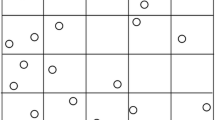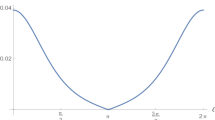Abstract
Samples taken at scattered points of a finite-support two-dimensional signal can be interpolated to recover an approximation of the original signal. Given a bound on the number of samples, where should they be placed to enable the most accurate reconstruction? Or, given an error bound for the reconstruction, what is the minimum number of samples required, and where should they be placed? In this paper we introduce search schemes that provide good candidate solutions to these problems, for digital signals. Natural Neighbour Interpolation is used in iterative sample removal and movement processes to obtain sparse sample patterns. For pictures and Digital Elevation Models, fewer samples are required if the interpolant is onlyC 0 continuous at the data sites, than if it isC 1. Retained samples lie on the ridges and valleys of the laplacian.
Similar content being viewed by others
References
P. Lancaster and K. Salkauskas,Curve and Surface Fitting: An Introduction. London and Toronto: Academic Press, 1986.
G. Farin, “Surfaces over Dirichlet tessellations,”Computer Aided Geometric Design, vol. 7, pp. 281–292, June 1990.
G. M. Neilson and R. Franke “Surface construction based upon triangulations,” inSurface in Computer Aided Geometric Design, edited by R. E. Barnhill and W. Borhm, pp. 163–177. Amsterdam: North-Holland, 1983.
D. Terzopoulos “Regularization of inverse visual problems involving discontinuities,”IEEE Transactions on Pattern Analysis and Machine Intelligence, vol. PAMI-8, pp. 413–424, July 1986.
J. A. Robinson, “Image coding with ridge and valley primitives,”IEEE Transactions on Communications, to appear.
D. Shepard, “A two-dimensional interpolation function for irregularly-spaced data,”Proceedings—1968 ACM National Conference, pp. 517–524, 1968.
P. Delfiner and J. P. Delhomme, “Optimum interpolation by Kridging,”Display and Analysis of Spatial Data, pp. 96–114, 1973.
J. L. De Bougrenet de la Tocnaye and J. F. Cavassilias, “Image Coding using an adaptive sampling technique,”Image Communication, vol 1, pp. 75–80, June 1989.
D. H. Douglas and T. K. Peucker, “Algorithms for the reduction of points required to represent a digitized line or its caricature,”Canadian Cartographer, vol. 10, pp. 112–122, 1987.
M. Sharif and B. Makarovic, “Optimizing Progressive and Composite Sampling for DTMS,”ITC Journal, Issue 2, pp. 104–111, 1989.
E. T. Bain,Automated generalisation of digital elevation models, Masters degree thesis, University of Waterloo, 1989.
R. Franke “Scattered data interpolation: test of some methods,”Mathematics of Computation, vol. 38, pp. 181–199, Jan. 1982
D. M. Zink,Accuracy Assessment of Interpolation Procedures for Digital Terrain Modelling, Masters of Arts thesis, University of Waterloo, Ontario, Canada, 1991.
R. J. Renka “Algorithm 624 triangulation and interpolation at arbitrarily distributed points in the plane,”ACM Transactions on Mathematical Software, vol. 10, pp. 440–442, Dec. 1984.
R. J. Renka and A. K. Cline, “A triangle-basedC 1 interpolation method,”Rocky Mountain Journal of Mathematics, vol. 14, pp. 223–237, 1984.
G. M. Neilson and R. Franke “A method for construction of surfaces under tension,”Rocky Mountain Journal of Mathematics, vol. 14, pp. 203–221, 1984.
L. B. Montefusco and G. Casciola, “Algorithm 677C 1 surface interpolation,”ACM Transactions on Mathematical Software, vol. 15, pp. 365–374, Dec. 1989.
W. J. Gordon and J. A. Wixom, “Shepard's methods of ‘metric interpolation’ to bivariate and multivariate interpolation,”Mathematics of Computation, vol. 32, pp. 253–264, Jan. 1978.
G. Matheron, “The intrinsic random functions and their applications,”Advances of Applied Probability, vol. 5, pp. 439–468, 1973.
R. Sibson, “A brief description of natural neighbour interpolant,”Interpreting Multivariate Data, Wiley Series in Probability and Mathematical Statistics, pp. 21–37, 1981.
M. S. RenTwo-Dimensional Signal Representation with Scattered Samples, Master of Applied Science Thesis, University of Waterloo, Waterloo, Ontario, Canada, 1992.
F. H. Moffitt and H. Bouchard,Surveying, 6th ed. Intext Educational Publishers, 1975.
R. E. Davis, F. S. Foote and J. W. Kelly,Surveying Theory and Practice, 5th ed. New York: McGraw-Hill, 1966.
Author information
Authors and Affiliations
Rights and permissions
About this article
Cite this article
Robinson, J.A., Ren, M.S. Data-dependent sampling of two-dimensional signals. Multidim Syst Sign Process 6, 89–111 (1995). https://doi.org/10.1007/BF00981566
Received:
Revised:
Issue Date:
DOI: https://doi.org/10.1007/BF00981566




